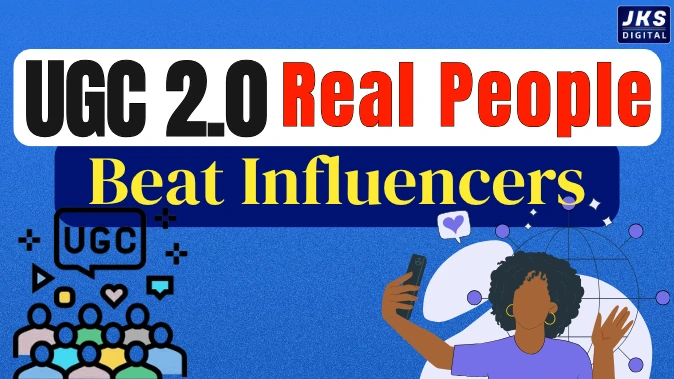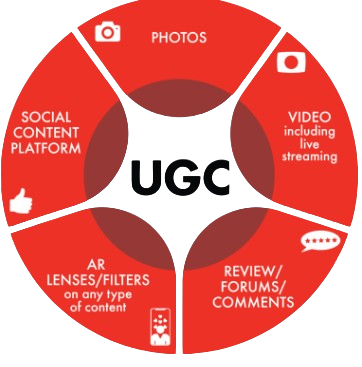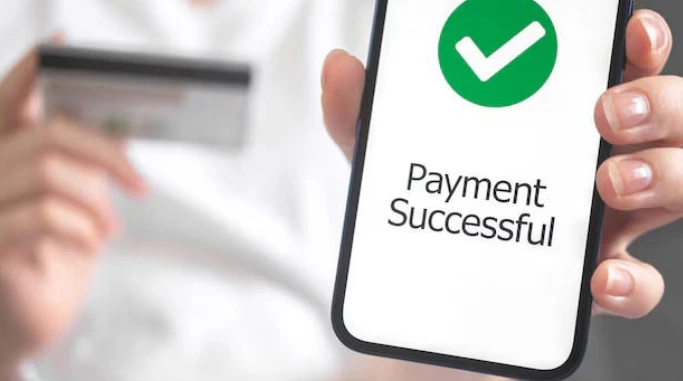UGC Boom 2.0:- A major shift is reshaping the digital marketing landscape, one that goes beyond the traditional influencer wave. This shift is known as UGC Boom 2.0. But what exactly does it mean?

UGC, or User Generated Content, refers to content created by real customers or everyday users—anything from unboxing videos, product try-ons, review reels, lifestyle clips, testimonials, to even face-less demo videos. Unlike influencer content, which is often scripted or overly polished, UGC reflects authentic human experiences.
UGC Boom 2.0 represents the upgraded era where brands actively prioritize genuine, relatable content over glamorous influencer promotions. The focus is now on real people sharing real experiences—messy, unfiltered, and authentic.
Why This New Era of UGC Has Emerged
In today’s fast-paced digital environment, consumers are more discerning than ever:
- They scroll through feeds rapidly, judging content in seconds.
- They can immediately detect over-edited influencer posts.
- They crave honesty and real-life experiences.
This is precisely why UGC 2.0 is booming—it resonates because it feels human, unscripted, and trustworthy.
Why Consumers Trust “Real People” More Than Brands
People connect with experiences, not advertisements. A recommendation from someone who genuinely uses a product feels more credible than a polished marketing message. This emotional connection is the heart of UGC 2.0. Consumers no longer want to be sold to—they want to see someone like them enjoying or reviewing a product.
2. UGC vs Influencer Marketing: The Big Shift
2.1 What Influencer Marketing Lacked
Influencer marketing revolutionized the digital marketing landscape initially, but over time, several limitations became apparent:

- Fake Lifestyles: Many influencers showcased glamorous lives that didn’t reflect actual product use, making audiences feel the content was staged rather than genuine.
- Declining Trust: The abundance of sponsored content caused viewers to become skeptical. Constant promotion made audiences question authenticity.
- High Costs, Low ROI: Brands often spent large amounts on influencer posts, but actual conversions were limited. Money was spent, yet the impact was often minimal.
As influencer marketing became more image-focused rather than impact-focused, a clear gap emerged—one that UGC creators could fill with authenticity and trust.
2.2 Why UGC Creators Are Winning
UGC (User-Generated Content) creators are succeeding because of their authenticity:
Read Also:- Why Keyword-Driven Content Is Dead: The Rise of Knowledge Hubs
- Real Content: They share genuine reactions and real product usage, which naturally feels relatable.
- Not Scripted: UGC is often unscripted, giving the impression of advice from a friend rather than a formal advertisement.
- Higher Engagement, Lower Costs: Audiences connect more easily with everyday people than polished influencers, increasing both trust and engagement.
This raw honesty forms the backbone of UGC 2.0, making it more effective and sustainable than traditional influencer campaigns.
3. Why Brands Are Paying More for Real People
3.1 Trust & Authenticity Is the New Currency
In today’s digital era, trust drives sales. If viewers trust a content creator, they are more likely to trust the product itself.
UGC creators deliver this trust through unfiltered, relatable content—without the need for glamorous filters or exaggerated promotions
3.2 Relatability Leads to Higher Conversions
When an everyday user shares a skincare transformation or product review, it creates an emotional connection.

Audiences think: “If someone like me benefits from this, I can too.”
This relatability often outperforms celebrity endorsements, as it transforms curiosity into purchase decisions faster.
3.3 Consumers Prefer “People Like Them”
UGC acts as powerful social proof. Consumers value peer recommendations over polished advertisements.
Real user recommendations feel credible, persuasive, and impactful, naturally influencing buying decisions more effectively than traditional ads.
3.4 Cost-Effective & Scalable Content Production
Instead of paying ₹50,000–₹500,000 for a single influencer post, brands can collaborate with multiple UGC creators, generating dozens of videos for the same budget.
Benefits include:
- More variety in content
- Consistent posting and engagement
- Scalable reach within budget
This approach is especially cost-effective and brand-friendly for small and medium-sized businesses.
4. Types of UGC Content Brands Want in 2025–26
Brands are increasingly prioritizing the following types of UGC:

- Product Unboxing Videos: Simple, honest, and highly watchable—these videos spark curiosity and build trust.
- Real Reviews & Testimonials: Verified user experiences boost credibility.
- Before–After Results: Visual proof naturally drives higher conversion rates.
- Short Reels/TikTok-Style Videos: Snackable content is ideal for short attention spans.
- Lifestyle Demonstrations: Showing products in real-life contexts adds emotional depth and relatability.
- Voiceovers + Face-less UGC: Creators can produce content without showing their face, maintaining privacy and accessibility.
The trend of UGC 2.0 will dominate 2025–26 due to its authenticity, relatability, and scalability, making it a key asset for brands
5. Why UGC Content Performs Better on Social Media
5.1 Better Watch Time & Engagement
Read Also:- The Secret to Social Media Growth in 2026 – Quality Over Quantity
Raw, unpolished content feels natural and keeps viewers engaged for longer periods, unlike polished, scripted ads.
5.2 Algorithms Favor Real Content
Platforms like Instagram, TikTok, and YouTube reward authenticity. Organic-feeling content is promoted more widely than staged advertisements.
5.3 Lower Ad Fatigue
Audiences are tired of highly polished ads but actively consume relatable, human content, making UGC a breath of fresh air.
5.4 Higher Conversion in Paid Ads
Paid campaigns featuring UGC consistently outperform traditional scripted ads across social media platforms, delivering higher ROI.
6. How Brands Use UGC in Their Marketing Funnel
UGC is effective at every stage of the marketing funnel:
- Awareness Stage – Real Experience Videos: Builds curiosity and initial trust.
- Consideration Stage – Reviews & Testimonials: Helps potential customers compare and validate products.
- Conversion Stage – Comparison & Demo Videos: Encourages confident purchase decisions.
- Retargeting Ads: Converts hesitant prospects more effectively than traditional ads, delivering the best ROI.
7. Industries Benefiting from UGC 2.0
UGC 2.0 is reshaping multiple industries:
- Beauty & Skincare: Transformation videos and tutorials dominate.
- Fitness & Nutrition: Supplement reviews and workout journeys resonate with audiences.
- Fashion & Clothing: Try-ons, styling tips, and outfit reviews drive engagement.
- Tech & Gadgets: Unboxing, setup guides, and honest comparisons boost sales.
- Hotels, Travel & Food: Real experiences create emotional connections and build trust.
8. What Makes a Good UGC Creator in 2026
Brands look for creators with the following qualities:
- Clear Camera Presence: Confident and visible, even if not perfect.
- Storytelling Skills: Engaging narratives that keep viewers hooked.
- Understanding Brand Tone & Goals: Content reflects brand identity.
- Ability to Shoot High-Quality Short Videos: Proper lighting, clean audio, and clear visuals are essential.
- Consistency & Professionalism: Brands value creators who deliver quality on time, every time.
9. How Much Brands Are Paying for UGC in 2026
Earnings potential for UGC creators continues to rise:

- Per Video Rates: ₹2,000 to ₹25,000 depending on quality and experience.
- Bundle Packages: 5–20 videos often offered at discounted rates.
- Monthly Retainers: Some creators earn fixed monthly income for consistent content.
- Rising Prices: Demand is exceeding supply as brands prioritize authentic content.
UGC 2.0 offers creators a sustainable income and brands a highly effective marketing strategy for 2026 and beyond.
10. How Brands Can Start a UGC Strategy
Launching a successful UGC strategy requires planning, creativity, and an understanding of what resonates with audiences. Here’s how brands can get started:
Find the Right Creators
The success of UGC campaigns begins with choosing real, relatable voices over polished influencers.
- Look for creators who use your products in everyday life and can naturally showcase experiences.
- Micro-creators (5K–50K followers) often outperform larger influencers in engagement, as their audience sees them as authentic peers.
- Example: A skincare brand might collaborate with a micro-creator who shares her daily morning routine rather than a celebrity posting a staged ad.
Provide Clear Guidelines
Brands should provide direction without over-scripting content:
- Define brand tone, messaging, and key points to highlight, but leave room for creator creativity.
- Avoid rigid scripts that strip away authenticity; audiences can detect overly polished content.
- Example: Instead of dictating exact dialogue, share “talk about your experience with the product and what you loved most” as a guideline.
Test with Multiple Creators
Experimentation is key:
- Collaborate with several creators simultaneously to understand which voices, styles, or formats resonate most with your audience.
- Track metrics like engagement, click-throughs, and conversions to refine your approach.
- Testing multiple formats also ensures variety in content, keeping your feed fresh and interesting.
Combine UGC & Paid Ads
UGC works best when paired with strategic paid campaigns:
- Organic, authentic content builds trust, while paid distribution ensures reach and scale.
- Example: A 30-second user testimonial can be turned into a sponsored ad targeting similar audiences, amplifying conversions.
- This hybrid approach maximizes ROI while maintaining authenticity.
11. Future of UGC 2.0
The next phase of UGC is evolving rapidly. Brands that embrace innovation and authenticity together will lead the way. Key trends include:
AI + Real People Hybrid Content
Combining AI-generated visuals with real human experiences is set to transform content creation:
- AI can assist with editing, captions, or even creating visual effects while the creator’s authentic story remains central.
- Example: A fashion brand could use AI to create dynamic product transitions while the influencer shares their genuine outfit review.
Voice-only UGC
Storytelling without visuals is gaining traction:
- Audio-first content like podcasts, voiceovers, or short voice clips allows creators to share experiences without showing their face.
- It’s ideal for privacy-conscious creators and offers a fresh way to engage audiences, especially in niches like fitness, wellness, or tutorials.
Brand-led UGC Communities
Instead of relying solely on influencers, brands are building communities of creators:
- Dedicated groups of micro-creators, enthusiasts, or loyal customers generate ongoing content.
- Example: A travel brand might create a “UGC ambassador program” encouraging travelers to share authentic experiences in exchange for rewards or recognition.
- This approach ensures a consistent flow of content and strengthens the brand-consumer relationship.
12. Conclusion: UGC Boom 2.0 Is Here to Stay
UGC is no longer a fleeting trend—it represents a permanent shift in digital marketing. Consumers are increasingly skeptical of polished advertisements but trust real people sharing genuine experiences.
Key takeaways:
- Authenticity is the new currency: Real, relatable content drives trust, engagement, and sales.
- Relatability converts faster than perfection: Audiences respond more to everyday people than celebrities or staged ads.
- Hybrid strategies are the future: Combining human stories with technology like AI or voice-first content expands reach while maintaining authenticity.
- Communities amplify impact: Brands that nurture ongoing creator communities benefit from a steady flow of credible, high-quality content.
The future belongs to real people sharing real stories. In this era, human authenticity holds far more value than glossy perfection. Brands that embrace UGC 2.0 will not only capture attention but also build lasting trust and loyalty in an increasingly skeptical digital world.





